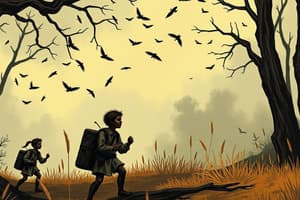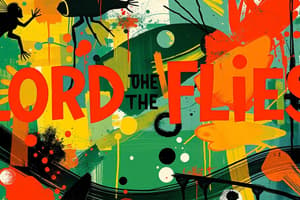Podcast
Questions and Answers
What seems to be happening regularly at midday?
What seems to be happening regularly at midday?
Many hallucinate
For what alleged reason do some of the boys smear themselves with colored clay?
For what alleged reason do some of the boys smear themselves with colored clay?
To camouflage themselves from the pigs
What does Piggy want the boys to make?
What does Piggy want the boys to make?
A sundial
What does Simon see that excites everyone?
What does Simon see that excites everyone?
What does Roger do that upsets the littluns?
What does Roger do that upsets the littluns?
What gives Littlun Henry so much pleasure as he pokes at the small forms of life in the pool with a stick?
What gives Littlun Henry so much pleasure as he pokes at the small forms of life in the pool with a stick?
What keeps Roger from actually hitting Henry with the stones he throws at the smaller boy?
What keeps Roger from actually hitting Henry with the stones he throws at the smaller boy?
What reason does Jack give for applying the colored clay to his face?
What reason does Jack give for applying the colored clay to his face?
Why couldn't the boys signal the ship that Ralph spotted on the horizon?
Why couldn't the boys signal the ship that Ralph spotted on the horizon?
Where were Jack and his choir when Ralph spotted the smoke on the ship?
Where were Jack and his choir when Ralph spotted the smoke on the ship?
Why does Jack attack Piggy, and what is the result of the attack?
Why does Jack attack Piggy, and what is the result of the attack?
What is Jack's reaction when Simon gives Piggy the meat?
What is Jack's reaction when Simon gives Piggy the meat?
Why do Roger and Maurice kick over the sandcastles of the younger children?
Why do Roger and Maurice kick over the sandcastles of the younger children?
Why does some sort of excuse come to Maurice's mind?
Why does some sort of excuse come to Maurice's mind?
What is symbolized by the distinction in Golding's coined words 'biguns' and 'littluns'?
What is symbolized by the distinction in Golding's coined words 'biguns' and 'littluns'?
What literary terms are used in the following quotations: 'The sun gazed down like an angry eye'?
What literary terms are used in the following quotations: 'The sun gazed down like an angry eye'?
Why, according to the narrator, does Roger not throw the rocks to hit Henry?
Why, according to the narrator, does Roger not throw the rocks to hit Henry?
In what sense does putting on the mask free Jack? Why might this liberation bode ill for the others?
In what sense does putting on the mask free Jack? Why might this liberation bode ill for the others?
What creates the barrier between Jack and Ralph?
What creates the barrier between Jack and Ralph?
What bloodthirsty chant has become part of their hunting ritual?
What bloodthirsty chant has become part of their hunting ritual?
What two worlds does the narrator say that Jack and Ralph depict?
What two worlds does the narrator say that Jack and Ralph depict?
Flashcards
Midday Hallucinations
Midday Hallucinations
A recurring phenomenon where the boys experience vivid, often disturbing, hallucinations in the middle of the day. It reflects their growing psychological distress, dehydration, and the oppressive environment they inhabit.
Clay Camouflage
Clay Camouflage
The boys use colored clay to create makeshift camouflage, which reflects their growing savagery, their desire to mimic animals, and their obsession with hunting.
Piggy's Sundial
Piggy's Sundial
Piggy's attempt to build a sundial symbolizes his longing for order, civilization, and an escape from the chaotic jungle environment.
Simon's Smoke
Simon's Smoke
Signup and view all the flashcards
Roger's Sandcastle Destruction
Roger's Sandcastle Destruction
Signup and view all the flashcards
Henry's Power Over Creatures
Henry's Power Over Creatures
Signup and view all the flashcards
Roger's Restraint
Roger's Restraint
Signup and view all the flashcards
Jack's Clay Camouflage
Jack's Clay Camouflage
Signup and view all the flashcards
Extinguished Signal Fire
Extinguished Signal Fire
Signup and view all the flashcards
Jack's Attack on Piggy
Jack's Attack on Piggy
Signup and view all the flashcards
Jack's Hostility Towards Simon
Jack's Hostility Towards Simon
Signup and view all the flashcards
Vandalized Sandcastles
Vandalized Sandcastles
Signup and view all the flashcards
Maurice's Guilt
Maurice's Guilt
Signup and view all the flashcards
Biguns and Littluns
Biguns and Littluns
Signup and view all the flashcards
Sun as an Angry Eye
Sun as an Angry Eye
Signup and view all the flashcards
Roger's Internal Struggle
Roger's Internal Struggle
Signup and view all the flashcards
Jack's Mask
Jack's Mask
Signup and view all the flashcards
Jack vs. Ralph
Jack vs. Ralph
Signup and view all the flashcards
Jack's Bloodthirsty Chant
Jack's Bloodthirsty Chant
Signup and view all the flashcards
Conflicting Desires
Conflicting Desires
Signup and view all the flashcards
Study Notes
Key Events and Themes
- Hallucinations occur regularly at midday among the boys, indicating psychological stress or dehydration.
- Boys smear colored clay on their faces to camouflage while hunting pigs, highlighting their descent into savagery.
- Piggy desires to create a sundial as a symbol of civilization and order, contrasting with the chaos developing.
- Simon sees smoke from a passing ship, representing hope for rescue, but the boys’ actions sabotage this chance.
- Roger destroys littluns' sandcastles, showcasing his emerging sadism and the breakdown of childhood innocence.
Dynamics of Power and Control
- Littlun Henry finds pleasure in controlling small forms of life, illustrating a desire for power in a chaotic environment.
- Roger refrains from hitting Henry with stones due to societal conditioning, showing the lingering effects of civilization's rules.
- Jack uses colored clay for hunting camouflage, reflecting his growing obsession with power and dominance over nature.
Conflict and Violence
- Ralph's signal fire is extinguished because Jack and the hunters prioritize killing a pig, resulting in missed rescue opportunity.
- Jack attacks Piggy in retaliation for being blamed for the extinguished fire, resulting in the destruction of Piggy's glasses, symbolizing the loss of reason and insight.
- Tensions rise as Jack reacts angrily to Simon for giving Piggy meat, indicating increasing tribalism and hostility among the boys.
Sociological Observations
- Roger and Maurice vandalize the sandcastles out of meanness, which represents a loss of childhood joy and the influence of societal norms breaking down.
- Maurice feels guilt conditioned by societal expectations, illustrating the conflict between innate savagery and upbringing.
- The terms "biguns" and "littluns" reflect the erosion of individuality and social structure, marking a shift towards a dualistic society on the island.
Literary Devices and Symbolism
- The sun is personified as "an angry eye," creating a vivid image of oppression and scrutiny, emphasizing the boys’ harsh environment.
- Roger's internal struggle foreshadows the future disintegration of the island's civilization, indicating a loss of societal constraints and morals.
- Jack's mask frees him from shame, suggesting a dangerous liberation from civilization's expectations, paving the way for emerging savagery.
Ideological Divergence
- A division forms between Jack and Ralph, symbolizing the clash between primal instincts (Jack) and the desire for order (Ralph).
- Jack's bloodthirsty chant reflects the transformation of the boys into savages, prioritizing violence over rescue.
- The narrative contrasts Jack's thrill in hunting with Ralph's longing for order, showcasing the conflicting desires within the group and foreshadowing further chaos.
Studying That Suits You
Use AI to generate personalized quizzes and flashcards to suit your learning preferences.




